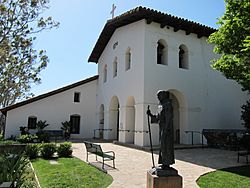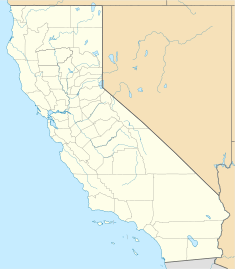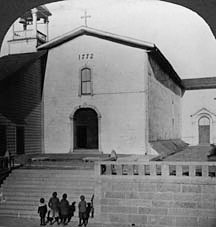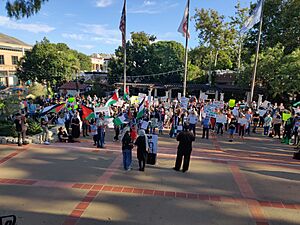Mission San Luis Obispo de Tolosa facts for kids

Missión San Luis Obispo de Tolosa in 2011.
|
|
| Location | 728 Monterey St. San Luis Obispo, California 93401 |
|---|---|
| Coordinates | 35°16′50″N 120°39′52″W / 35.28056°N 120.66444°W |
| Name as founded | La Misión de San Luís Obispo de Tolosa |
| English translation | The Mission of Saint Louis Bishop of Toulouse |
| Patron | Saint Louis of Anjou, Bishop of Toulouse, France |
| Nickname(s) | "Prince of the Missions" "Mission in the Valley of Bears" "The Accidental Mission" |
| Founding date | September 1, 1772 |
| Founding priest(s) | Father Presidente Junípero Serra |
| Founding Order | Franciscan |
| Military district | Third |
| Native tribe(s) Spanish name(s) |
Chumash Obispeño |
| Native place name(s) | Tilhini |
| Baptisms | 2,644 |
| Marriages | 763 |
| Burials | 2,268 |
| Governing body | Diocese of Monterey |
| Current use | Parish Church / Museum |
| Reference no. | 325 |
| Website | |
| http://www.missionsanluisobispo.org | |
Mission San Luis Obispo de Tolosa is a historic Spanish mission. Father Junípero Serra founded it on September 1, 1772. It is located in San Luis Obispo, California. The mission was named after Saint Louis, a bishop from Toulouse, France.
This mission has a unique design. Its bell tower and entrance area are different from other California missions. The main part of the church, called the nave, is short and narrow. But this mission also has a second nave. It is almost the same size and sits to the right of the altar. This makes it the only L-shaped mission church in California.
Contents
History of the Mission
How the Mission Started (1772)
In 1769, a Spanish explorer named Gaspar de Portolá traveled through California. He passed through the area where San Luis Obispo is today. A missionary named Juan Crespí was with him. Crespí wrote that the soldiers called the place "llano de los osos." This means "plain of the bears."
Later, food became scarce at the first mission in Monterey. Father Junípero Serra remembered the "valley of the bears." He sent a hunting group to San Luis Obispo. They found plenty of food there. This made Father Serra think about building a new mission in the area.
He found that San Luis Obispo was a great spot. It had many natural resources and good weather. The local Chumash people lived there too. Father Serra decided to build the fifth mission in the chain. The Spanish relied on the local Chumash people for help with building and farming. Once people joined the mission, they were expected to stay.
Father Serra sent a group to start building. On September 1, 1772, they put up a cross. Father Serra held the first church service. He then left Father José Cavaller in charge of building. The mission was named after Saint Louis, Bishop of Toulouse. This saint was important to the Franciscan order.
Father Cavaller used Chumash labor to build temporary wooden fences, called palisades. These served as the first mission buildings. However, some Native American tribes set these buildings on fire. This was an act of resistance against the new European settlements. The buildings were then rebuilt using stronger adobe bricks and roof tiles.
From 1794, Mission San Luis Obispo had many new buildings added. These included homes for local Native Americans and improvements to the mission. There were also storerooms, homes for single women, and soldier barracks. Mills for grinding grain were also built.
The main building project finished in 1819. This was when the central courtyard, or quadrangle, was completed. A year later, two mission bells arrived from Peru. These bells marked the end of major improvements for many years.
In 1830, Father Luis Gil y Taboada took over the mission. He passed away three years later. In 1842, Father Ramon Abella died. He was the last Franciscan priest at the mission for the next 40 years.
The Rancho Period (1834–1849)
In 1845, Governor Pío Pico sold the mission. Captain John Wilson bought it for $510. During a conflict with Mexico in 1846, John C. Frémont used the mission. His "California Battalion" used it as a base.
During this time, the mission fell into disrepair. This was due to a law that changed how missions were run. The remaining priests rented out rooms to help support the mission.
California Becomes a State (Since 1850)
Mission San Luís Obispo de Tolosa became important in a new way. It served as the first courthouse and jail for San Luis Obispo County, California.
In 1850, California joined the United States. The first California bishop, Joseph Alemany, asked the government to return mission lands to the Church. Since then, the mission has seen many changes.
In the 1880s, an earthquake damaged the front porch and bell tower. These parts were removed. People tried to "modernize" the buildings. The columns along the front of the convent were taken down. The church and residence were covered with wooden siding. A new bell tower, like those in New England, was added. These changes protected the building from further damage. However, they greatly changed how the mission looked.
In the 1930s, Father John Harnett led a big restoration project. The goal was to bring the buildings back to their original mission style. An addition from 1893 was made larger in 1948. Today, the mission is in the busy downtown area. It serves as a Catholic parish church for the city. It is part of the Diocese of Monterey.

Mission Plaza
In 1970, the Mission was recognized as the heart of San Luis Obispo. This happened with the creation of Mission Plaza. Mayor Ken Schwartz worked with students from Cal Poly. They planned to close Monterey Street in front of the mission. This would create a public space. Construction of the plaza began in 1969. It was officially opened in 1970.
A statue of Junípero Serra was placed in the plaza. It faced the public area. In recent years, there has been discussion about statues of historical figures. This includes statues of Junípero Serra. These discussions are about the impact of European colonization on Native American communities. In 2020, the statue was moved into storage on the mission grounds.
The plaza in front of the mission is often used for public gatherings. People hold demonstrations and protests there.
See also
 In Spanish: Misión San Luis Obispo de Tolosa para niños
In Spanish: Misión San Luis Obispo de Tolosa para niños
- List of Spanish missions in California
- Mission San Luis Obispo – a ship built during World War II.
- City of San Luis Obispo Historic Resources




